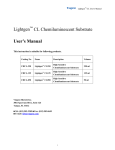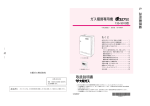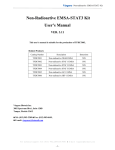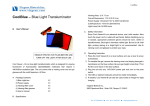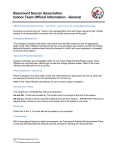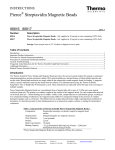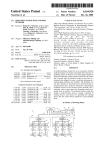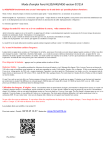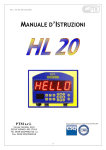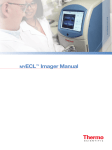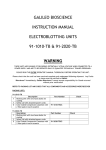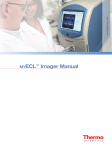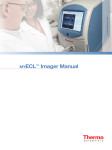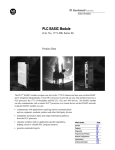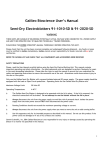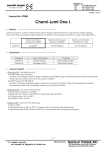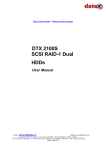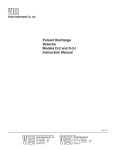Download Lightgen HL Chemiluminescent Substrate User`s Manual
Transcript
LightgenTM-HL User’s Manual Lightgen™ HL Chemiluminescent Substrate User’s Manual This instruction is suitable for following products. Catalog No Name Description Volume CHHL-100 Lightgen™ HL100 High Sensitive Chemiluminescent Substrate 100 ml CHHL-050 Lightgen™ HL50 High Sensitive Chemiluminescent Substrate 50 ml CHHL-020 Lightgen™ HL20 High Sensitive Chemiluminescent Substrate 20 ml Viagene Biotech Inc. 3802 Spectrum Blvd., Suite 128B Tampa, Florida 33612 ◙ Tel: (813) 902-2209 ◙ Fax: (813) 903-0649 ◙ E-mail: [email protected] 1 LightgenTM-HL User’s Manual TABLE OF CONTENTS A. Introduction ........................................................... 3 B. Kit components ...................................................…. 3 C. Additional material required ................................... 4 D. Procedures .........................................................…. 4 E. Precautions F. Troubleshooting ..................................................... 6 G. Related Viagene Products .................................…. 7 H. Warranty ................................................................. 8 I. References .........................................................…. 8 .......................................…………...5 2007© Viagene Biotech, Inc. All rights reserved. 2 LightgenTM-HL User’s Manual A. Introduction Lightgen™ HL is a chemiluminescent substrate with extremely high sensitivity, used for detecting Horseradish Peroxidase in Northern/Southern Hybridization, Electrophoretic Mobility Shift Assay (EMSA) and Western blotting (HRP) by a digital imager. When incubating with HRP, it emits a strong blue light, which can be detected by a CCD imager or X-Ray films. Detecting sensitivity can reach to femtogram level of HRP when Lightgen™ HL is used. Lightgen™ HL is very easy to use, highly sensitive and stable, suitable for experiments which use nitrocellulose, PVDF or Nylon membranes. Since Lightgen™ HL is much more sensitive than other chemiluminescent substrates in the market such as ECL, LumiGLO, Renaissance, Western Lightnight™, it will be necessary to optimize the dilution of antibodies, hybridization probes or HRP-conjugates to obtain best results. Please refer to the procedure section for details. B. Kit components 1. 100 ml Substrate Kit: CHHL100 Lightgen™ HL Solution A, 50 ml Lightgen™ HL Solution B, 50 ml Sufficient for 60 - 300 pieces of (7 x 8 cm) membrane or 3,000 – 15,000 cm2 membrane. 2. 50 ml Substrate Kit: CHHL050 Lightgen™ HL Solution A, 25 ml Lightgen™ HL Solution B, 25 ml Sufficient for 30 - 150 pieces of (7 x 8 cm) membrane or 1,500 – 7,500 cm2 membrane. 3. 20 ml Substrate Kit: CHHL020 Lightgen™ HL Solution A, 10 ml Lightgen™ HL Solution B, 10 ml Sufficient for 12 - 60 pieces of (7 x 8 cm) membrane or 600 - 300 cm2 membrane. 3 LightgenTM-HL User’s Manual C. Additional materials required (not included): Lightgen™ HL is designed for detecting the activities of HRP on nitrocellulose, PVDF or Nylon membranes. Before proceeding, please have the following materials ready. 1. Any one of the following completely reacted membranes: - In Western Blots, membranes should have been incubated with primary and HRP-conjugated secondary antibodies. They should be ready for chemiluminescent detecting. - In Northern and Southern Hybridization, membrane should have been hybridized with HRP-conjugated probes and ready for chemiluminescent detecting. - In EMSA, membrane should been incubated with detecting reagents and ready for chemiluminescent detecting. 2. A CCD image-detector, specifically for pickup Chemiluminescent signals, such as Viagene’s Cool Imager™, or X-rays films, a film developer, and related chemicals and reagents. D. Procedures 1. Detection with a CCD Imager: A CCD imager should have high sensitivity and capable of capturing all the needed data in 5-10 minutes. Viagene’s Cool Imager™ is an example of choice to capture images for Western Blots, Northern and Southern hybridizations or EMSA. Detecting and analyzing images with the CCD imager is much easier than X-Ray films. Following operation is for Viagene’s Cool Imager™. 1) Turn on Cool Imager™ and pre-cool the system for 1-2 minutes. 2) Make application mixture for each 7 X 9 cm membrane. Solution A 1ml Solution B 1ml Total 2ml 4 LightgenTM-HL User’s Manual 3) Place the membrane on a leveled and sturdy hydrophobic surface such as on a piece of a parafilm with a piece of glass under. Cover the entire membrane evenly with the substrate mixture. 4) Make sure the membrane is covered with the substrate mixture evenly and then put the membrane with substrate solution on it into the imager. 5) Follow the detailed instructions in the Cool Imager™ user’s manual. In general, 2-5 minutes of capturing should be sufficient to obtain a chemiluminescent image. 6) Adjust the capturing time to obtain optimal images. 7) Use the Cool Imager™ Software to analyze and quantify the image. 8) Refer to the user’s manual of Cool Imager™ for all the details and other functions. 2. Detection by exposing to X-rays films: When using X-ray films, make sure a dark room and a X-ray film developer are available, have enough X-ray films, chemicals and reagents. 1) Turn on and pre-warm the X-ray film developer. 2) Mix enough amount of substrate mixture [refer to diction D.1.2]. For example, each 9 X 7 cm membrane needs at least 2.0 ml total volume of the mixture. 3) Cover the entire membrane evenly with the substrate mixture and let it react at room temperature for 1-2 minutes. 4) After the reaction, discard the substrate on the membrane and then cover it with a clear plastic film. 5) In the dark room, put a sheet of X-ray film on the wrapped membrane. Since it is difficult to pre-determine the exposure time for each experiment, it may be necessary to try different exposure time to obtain best results. E. Precautions 1. In order to obtain best results, it is important to use high-quality experiment materials, equipments, such as samples quality, probes and antibodies concentration, membrane quality, etc. 2. Because LightgenTM HL has extremely high sensitivity, it will be necessary too optimize the dilution of antibodies, hybridization probes or HRP-conjugates. In the experiments using Lightgen™ HL only 1/3 to 1/5 of amounts of samples, antibodies or probes used in the experiment with the substrates rather than LightgenTM HL, is required. 3. Before the experiment, it is recommended to check the concentration of probes and antibodies by performing the dot-blot analysis. 4. All the containers used in chemiluminescent experiments should be cleaned thoroughly. Always wear gloves or use cleaned forceps to handle membranes to avoid high background. Don’t let membranes 5 LightgenTM-HL User’s Manual dry out during experiments. 5. Choose an appropriate blocking buffer. There is not a certain generic buffer for all Western blot, Northern and Southern hybridization, and EMSA. Choosing the appropriate blocking buffer may increase chemiluminescent sensitivity and reduces nonspecific background. 6. Avoid using milk in blocking buffer when using avidin/biotin systems because milk contains variable amounts of endogenous biotin. 7. Adding Tween®-20 or other high quality detergent to the blocking and washing buffers may reduce nonspecific background. 8. Washing and blocking buffers cannot contain sodium azide as it will inhibit HRP activity. 9. Because the chemiluminescence decays over time, the first 5-30 minute reaction of HRP and chemiluminescent substrate produces the strongest chemiluminescence. In order to obtain best results, capturing chemiluminescent images with different exposure time is necessary. 10. During detection of chemiluminescent images, any movement of CCD camera or X-ray films on the membrane should be avoided to obtain best results. 11. Solution A and B should be stored in their own bottles at 4oC for long-term storage. At room temperature, the substrate mixture is stable for ~72 hours and exposure it to direct light may reduce its stability. However, short-time exposure to lab lighting has no effects on substrate solutions. F. Troubleshooting: Problems White spots in the center of dark chemiluminescent bands. Possible Causes Recommendation Too much HRP on sample area digests the substrate quickly and diminish chemiluminescence. Dilute Probes, antibodies or HRP-conjugates more. Insufficient interaction of antigen & antibody. Increase amount of antigen or antibody Insufficient hybridization Increase amount of RNA/DNA and probes. Inefficient protein transfer Optimize protein transfer Brown or yellow spots on the membrane Very weak or no signal 6 LightgenTM-HL User’s Manual Low HRP or substrate activity Increase HRP-conjugates Too much HRP Dilute HRP-conjugate more Insufficient blocking Optimize blocking conditions Inappropriate blocking buffer Try another blocking buffer Inadequate washing Increase washing time and/or volume of washing solution Film or CCD camera have been overexposed Decrease exposure time Concentration of antigen or antibody is too high Reduce amount of antigen or antibody used in experiments. Inefficient protein transfer Optimize protein transfer procedure Unevenly hydrated membrane Follow manufacturer’s recommendations Bubbles between film and the membrane Remove all bubbles before film exposure. Aggregate formation in the HRP-conjugate Filter conjugate through a 0.2 μm filter Too much HRP in the system Dilute HRP-conjugate at least 10-fold SDS caused nonspecific binding to protein bands Do not use SDS during immunoassay procedure High background White spots on the membrane randomly. Speckles on the film background Nonspecific bands G. Related Viagene Products IMGR002 Cool Imager™ chemiluminescent imager workstation TFDET001 Non-radioactive NF-KB EMSA Kit (50 reactions) TFDET002 Non-radioactive STAT1 EMSA Kit (50 reactions) TFDET003 Non-radioactive STAT3 EMSA Kit (50 reactions) TFDET004 Non-radioactive STAT5 EMSA Kit (50 reactions) TFDET005 Non-radioactive AP-1 EMSA Kit (50 reactions) TFDET006 Non-radioactive HIF-1 EMSA Kit (50 reactions) 7 LightgenTM-HL User’s Manual H. Warranty Thank you for choosing Viagene products. Viagene Biotech Inc. guarantees that LightgenTM will perform as they are intended for and indicated in each manual. Products are warranted for 1 year from the date of purchase unless otherwise specified. During the warranty period, if problems arise, Viagene will be responsible for products exchange or return. All Viagene products are for research purposes only. No resale, distribution or sale modified products of Viagene Biotech, unless written permission is granted. Viagene Biotech Inc. strives for complete customer satisfaction, if you are not satisfied with Viagene’s products would like to give us comments, please contact Viagene Biotech customer service. I. Warranty 1. CRC Handbook of Immunoblotting of Proteins: Volume 1 Technical Description. Eds Ole J.Bjerrum, Ph. D., M. D. and Niels H. H. Heegaard, M.D. CRC Press, Inc.: Boca Raton, FL, 1988. 2. Kaufmann, S. H., et al. (1987). The erasable Western blot. Anal. Biochem. 161:89-95. 3. Mattson, D. L. and Bellehumeur, T. G. (1996). Comparison of three dhemiluminescent horseradish peroxidase substrates for immunoblotting. Anal. Biochem. 240:306-308. 4. Walker, G. R., et al. (1995). SuperSignal™ CL-HRP: A new enhanced chemiluminescent substrate for the development of the horseradish peroxide label in Western blotting applications. J. of NIH Research 7:76. * ECL™ a trademark of Amersham Pharmacia Biotech. LumiGlo® is registered trademark of KPL, Inc. Western Lightning™ is a trademark of PerkinElmer Life Sciences. Renaissance™ is a trademark of NEN Life Science Products. Tween® is a registered trademark of ICI Americas. Cool Imager™ and Lightgen™ HL are trademarks of Viagene Biotech Inc. Please visit us at www.viagene.com for latest news and products information. 8








